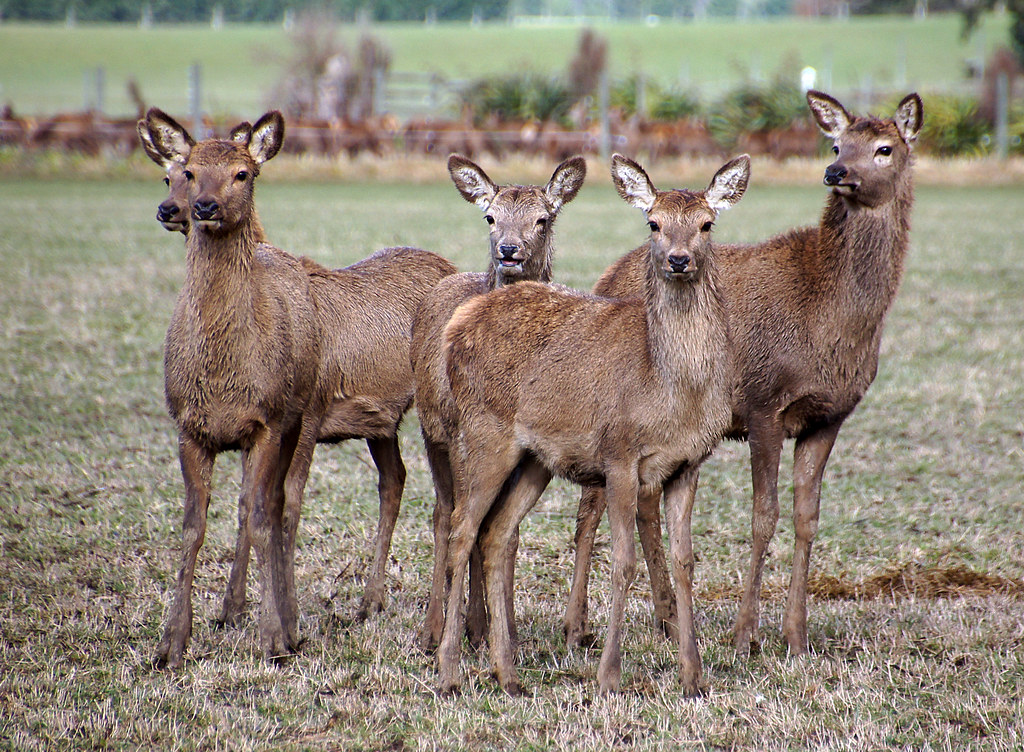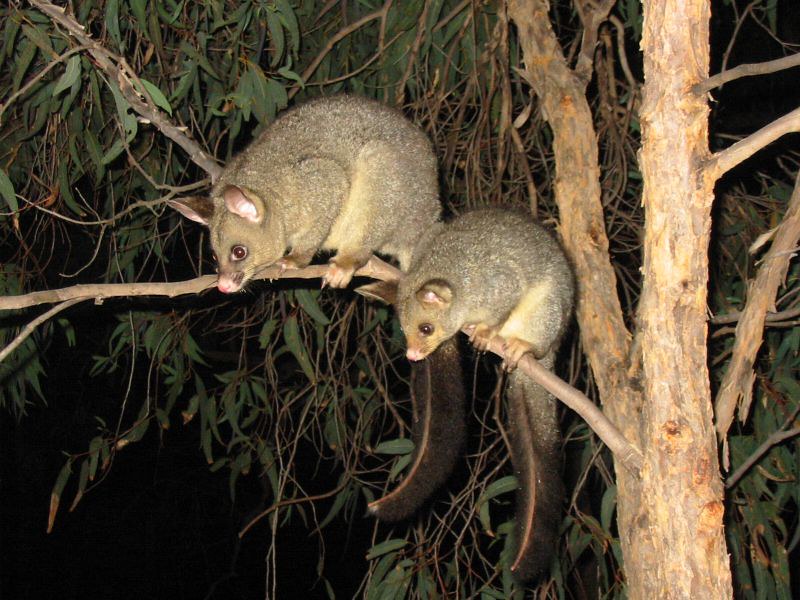Among the non-native species damaging forest systems are mammals – introduced deer, goats and sheep, and swine, … These animals have the greatest impacts on island systems that are sufficiently isolated that they have no native terrestrial mammals, e.g., Hawai`i and New Zealand. Several New Zealanders have published a study of their impacts (Allen et al.; full citation at end of the blog). The focus of their analysis is the native forests’ ability to sequester carbon and thus mitigate climate change. The scientists are well aware, however, that forests provide many other ecosystem values and services, including biodiversity, water supply and quality, etc.
Introduced ungulates can have many direct effects: reduction and damage to understory biomass, depletion of seedling regeneration, exacerbated soil erosion, and local nutrient imbalances. Mammals’ browsing can modify the composition of plant communities by favoring abundance of unpalatable species. Changes also can alter ecosystem functions associated with nutrient cycling, e.g., by reducing nutrient returns to the soil and altering rates of litter decomposition
In these ways, introduced ungulates exert long-term impacts on forests’ capacity to store carbon.
Allen et al. aimed to determine the extent of these effects on forests’ capacity to store carbon, both above- and below-ground, and on forest structure and diversity. The authors compared data from 26 pairs of sites across New Zealand – half with ungulate exclosures and half adjacent unfenced control plots. The ungulate exclosures had all been established for at least 20 years. All the sites were in species-rich communities of conifers and broadleaved evergreen angiosperm trees. These forests (1) cover about one-third of the country’s remaining mature natural forest; (2) contain tree species of a wide range of palatability to ungulate herbivores; and (3) have been named a conservation priority for forest carbon management. The ungulates present on the plots were European red deer (Cervus elaphus), fallow deer (Dama dama), sika deer (Cervus nippon), and feral goats (Capra hircus).
They assert that New Zealand is a good place to do this type of study because ungulate introductions are relatively recent so their impacts are well documented.
Allen et al. found that managing invasive ungulates makes valuable contributions to conserving biodiversity but not to carbon sequestration. They found little difference in total ecosystem carbon between ungulate exclosures and unfenced control plots. Most of the difference they did find was explained by the biomass of the largest tree within each plot. As they point out, these large trees have been unaffected by invasive ungulates introduced during the last 20–50 years. However, they believe ungulate-caused changes in understory biomass, species composition, and functional diversity might result in major shifts in the diversity and composition of regenerating species. Hence, longer term consequences for both ecosystem processes and storage of forest carbon storage can be expected.
Indeed, excluding ungulates did increase the abundance and diversity of saplings and small trees. The basal area of the smallest class of tree size was 70% greater. Species richness of small trees and saplings was 44% and 68% higher, respectively. This difference had little impact on overall carbon storage, however, because the small trees and saplings store only about 5%. In contrast, the largest tree size class (dbh =/>30 cm), with their roots, contributed 44% of total ecosystem carbon in both exclosure and control plots. The largest effects of exclosures on carbon stocks were in early successional stands, e.g., those affected by such major disturbances as windthrow, volcanic activity, or landslides.
Climate change is expected to cause surprising interactions among forest productivity, herbivory, disturbance. Allen et al. suggest that authorities should focus on excluding ungulates on these highly productive regenerating forests rather than old-growth forests. I am disturbed by this suggestion. It exposes the most biologically diverse forests to continuing damage.
Data gaps
New Zealand has many long-lived, slow-growing tree species. Recruitment of understory trees is already low across both main islands. This situation has been attributed to ungulate browsing. Over centuries, this might result in shifts in the canopy composition. Allen et al. call for additional research to increase our understanding of how browsing and other short-and long-term drivers affect the regeneration of large trees. Also, data on soil CO2 emissions needs better integration.
The study did not consider the impact of other introduced mammals, such as feral pigs (Sus scrofa), rodents, and Australian brushtail possum (Trichosurus vulpecula). The possum is known to damage New Zealand trees. The scientists did not explain this omission; I assume it might have been the result of either lack of resources to support a broader study or differences in management strategies – or both?
I note that the study also did not address the extent to which non-native pathogens threaten these large trees. In response to my query, Kara Allen said that their plots did not include many kauri (Agathis australis) trees, so the severe dieback disease caused by Phytophthora agathidicida did not affect their results. Naturally regenerating kauri is limited to a small area of warm temperate rainforests located at the top of the North Island. So kauri potentially play a relatively small role in terms of overall carbon stocks in New Zealand’s forests. On the other hand, Allen says that myrtle rust (Austropuccinia psidii) could have a major impact on New Zealand forests’ carbon storage. Trees in the host family, Myrtaceae, are ecologically important across both islands. Also, they comprise a large portion of overall forest carbon stocks (ranked in the top 5 largest families for above- and belowground biomass). An example is southern rata (Mterosideros umbellata), which are preferentially fed on by Australian brush possum.
Bernd Blossey, (free access!) who has long studied the role of high deer populations in North American forests, praises the study’s attempt to measure data, not just rely on models, and its inclusion of soil. However, he notes other limitations of the New Zealand study:
- The small exclosures (20 x 20 m) are subject to edge effects. Some of Blossey’s exclosures occupy 2 hectares.
- Twenty years is too short a time for analysis of such long-term processes as carbon sequestration and regeneration of slow-growing trees. Therefore, any results must be considered preliminary. Furthermore, no one recorded any differences in carbon sequestration of the paired plots at the time the exclosures were set up.
- There’s no mention of possible impacts by introduced earthworms.
Dr. Blossey recognizes that the current study’s authors cannot re-do actions taken decades in the past. Still, the data gaps reduce the value of the findings.
I conclude that uncertainties continue due to: the long timelines of species’ regeneration and growth to full sizes; the requirement for large exclosures; the complexity of factors affecting carbon sequestration; and probably other influences.. Managers trying to maximize carbon sequestration are forced to act without truly knowing the best strategy or how their actions will affect the future.
For more about invasive mammals’ impacts in U.S. forests, also see the study by USFS scientists, Poland et al. (full citation listed in sources). One can enter “mammal” in the search box for the on-line PDF.
SOURCES
Allen, K., P.J. Bellingham, S.J. Richardson, R.B. Allen, L.E. Burrows, F.E. Carswell, S.W.Husheer, M.G. St. John, D.A. Peltzer, M. Whenua. 2023. Long-term exclusion of invasive ungulates alters tree recruitment and functional traits but not total forest carbon. Ecological Applications. 2023; e2836. https://onlinelibrary.wiley.com/r/eap
Poland, T.M., Patel-Weynand, T., Finch, D., Miniat, C. F., and Lopez, V. (Eds) (2019), Invasive Species in Forests and Grasslands of the United States: A Comprehensive Science Synthesis for the United States Forest Sector. Springer Verlag. The on-line version as at https://link.springer.com/book/10.1007/978-3-030-45367-1
Posted by Faith Campbell
We welcome comments that supplement or correct factual information, suggest new approaches, or promote thoughtful consideration. We post comments that disagree with us — but not those we judge to be not civil or inflammatory.
For a detailed discussion of the policies and practices that have allowed these pests to enter and spread – and that do not promote effective restoration strategies – review the Fading Forests report at http://treeimprovement.utk.edu/FadingForests.htm
or


